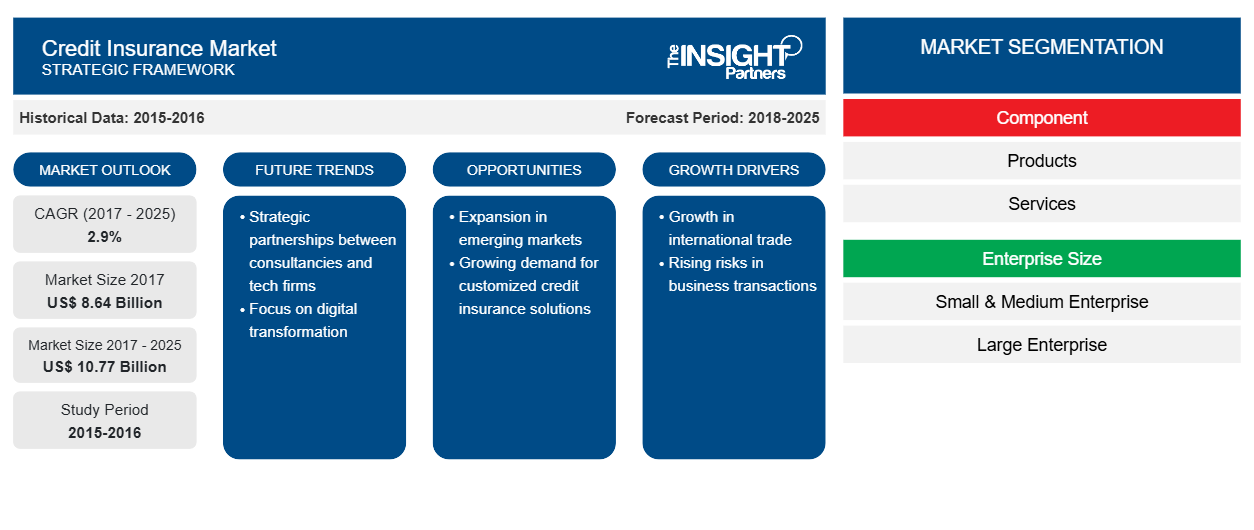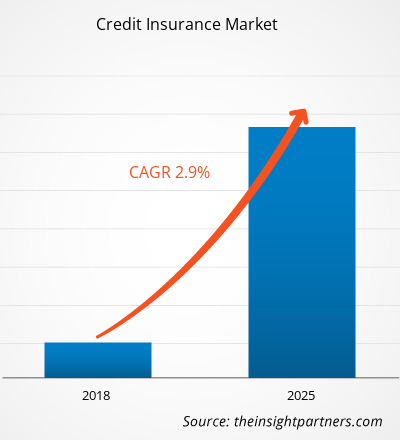2017 年信用保险市场价值为 86.4 亿美元,预计到 2025 年将达到 107.7 亿美元。预计在 2017 年至 2025 年的预测期内,信用保险市场将以 2.9% 的复合年增长率增长。
信用保险市场是指涉及财产和意外伤害保险的保险类型。全球的贸易商、商人或出口商面临着与付款缓慢、债务人破产和破产有关的严峻挑战。这一因素提高了发达地区和发展中地区信用保险政策的采用率。信用保险吸引消费者的主要好处是,保险政策可以保护公司免于不支付商业债务。全球贸易部门在国内市场和国际市场上都经历了显着增长,欧洲和北美是出口各种商品和产品的领先者。亚太地区、中东和非洲以及拉丁美洲的国家对贸易和出口产品的需求不断增加。全球信用保险市场预计将在不久的将来呈现高增长。推动市场增长的一些主要驱动因素包括全球宏观经济不稳定,这对贸易商构成了严重的商业威胁,从而增加了信用保险的采用。另一个促进需求的因素是公司提供不同的服务,包括销售支持和应收账款支持。然而,全球信用保险市场的增长导致保单持有人和保险承保人都出现了多起与保险索赔有关的欺诈案件。
全球信用保险市场根据组成部分细分为产品和服务两大部分。在全球信用保险市场运营的公司根据客户或客户的要求设计和创新强大的产品和服务。全球信用保险市场根据企业规模进一步分为中小型企业 (SME) 和大型企业。多年来,大型企业在全球信用保险市场占据了相当大的市场份额。信用保险的不同应用类型包括国内贸易市场和出口贸易市场。应用中的出口部分更加突出,近年来国内市场对信用保险产品和服务的需求日益重要。全球信用保险市场分为五个战略区域,即北美、欧洲、亚太、中东和非洲以及南美。从地理上看,当前市场中最主要的两个地区是欧洲和北美。
定制此报告以满足您的需求
您可以免费定制任何报告,包括本报告的部分内容、国家级分析、Excel 数据包,以及为初创企业和大学提供优惠和折扣
- 获取此报告的关键市场趋势。这个免费样品将包括数据分析,从市场趋势到估计和预测。
信用保险市场洞察
提高销售和应收账款支持效益,增加信用保险需求
如今,企业不断专注于提高技术、服务和客户群,以便逐年提高销售额。信用保险公司帮助制造商、分销商、供应商和其他商业贸易商利用增强的知识选择合适的客户,从而优化贸易商,提高公司的盈利能力。选择不合适或错误的客户会导致信用违约或延迟付款,这又会对公司的销售产生负面影响。信用保险还通过规定公司运营所在的全球市场动态和知识,提供对特殊出口风险的保护。这让贸易商有机会进军不同的地区,从而增加客户群,最终提高销售额。这一因素还可以减轻客户较少的公司的潜在风险。这些因素使贸易商,尤其是出口业务公司,比同行业的其他贸易商更具竞争优势。
基于组件的市场洞察
信用保险市场已根据组成部分细分为产品和服务。产品是承保人提供的保险单,有助于保险购买者或交易者了解市场情况以及与买方业务相关的风险。这一因素是组件部分下产品部分的主要驱动力。另一方面,保险公司也在投入时间和精力为客户提供更优质的服务,这推动了全球商品领域对信用保险的需求。
基于企业规模的市场洞察
全球信用保险市场根据企业规模分为中小型企业和大型企业。信用保险公司向各级企业提供产品和服务,并根据企业规模、年收入、交易历史、历史债务损失、贸易部门和客户群调整政策和服务。如果投保人选择政治风险承保,大型企业和中小型企业的保费金额都较高。
信用保险市场的参与者专注于市场举措、收购和产品发布等策略,以保持其在信用保险市场中的地位。信用保险市场主要参与者的一些发展如下:
2018 年 6 月,Atradius NV 在保加利亚索非亚开设了分公司,通过稳步扩大出口和高 GDP 增长率,加强其在蓬勃发展的保加利亚市场的战略地位,创造了可观的信用保险市场规模。
2018年9月,科法斯宣布已签署收购PKZ的具有约束力的协议。
信用保险市场区域洞察
Insight Partners 的分析师已详细解释了预测期内影响信用保险市场的区域趋势和因素。本节还讨论了北美、欧洲、亚太地区、中东和非洲以及南美和中美洲的信用保险市场细分和地理位置。

- 获取信用保险市场的区域具体数据
信用保险市场报告范围
| 报告属性 | 细节 |
|---|---|
| 2017年市场规模 | 86.4 亿美元 |
| 2025 年市场规模 | 107.7亿美元 |
| 全球复合年增长率(2017 - 2025) | 2.9% |
| 史料 | 2015-2016 |
| 预测期 | 2018-2025 |
| 涵盖的领域 | 按组件
|
| 覆盖地区和国家 | 北美
|
| 市场领导者和主要公司简介 |
|
市场参与者密度:了解其对商业动态的影响
信用保险市场正在快速增长,这得益于终端用户需求的不断增长,而这些需求又源于消费者偏好的不断变化、技术进步以及对产品优势的认识不断提高等因素。随着需求的增加,企业正在扩大其产品范围,进行创新以满足消费者的需求,并利用新兴趋势,从而进一步推动市场增长。
市场参与者密度是指在特定市场或行业内运营的企业或公司的分布情况。它表明在给定市场空间中,相对于其规模或总市场价值,有多少竞争对手(市场参与者)存在。
在信用保险市场运营的主要公司有:
- 裕利安怡
- 安卓公司
- 科法斯公司
- 美国国际集团有限公司
- 克雷登多
免责声明:上面列出的公司没有按照任何特定顺序排列。

- 了解信用保险市场顶级关键参与者概况
信用保险市场 – 按组成部分
- 产品
- 服务
信用保险市场 – 按应用分类
- 国内的
- 出口
信用保险市场 – 按企业规模
- 中小企业
- 大型企业
信用保险市场 – 按地区划分
- 北美
- 我们
- 加拿大
- 墨西哥
- 欧洲
- 法国
- 德国
- 西班牙
- 英国
- 意大利
- 欧洲其他地区
- 亚太地区 (APAC)
- 中国
- 印度
- 日本
- 韩国
- 亚太地区其他地区
- 中东及非洲
- 沙特阿拉伯
- 阿联酋
- 南非
- MEA 其他地区
- 山姆
- 巴西
- SAM 其余部分
信用保险市场 – 公司简介
- 美国国际集团
- 安卓公司
- 东芝
- 中国出口信用保险公司
- 科法斯公司
- 克雷登多
- 欧拉·赫尔墨斯
- 加拿大出口发展局
- Qbe 保险集团有限公司
- 苏黎世保险集团
- 历史分析(2 年)、基准年、预测(7 年)及复合年增长率
- PEST 和 SWOT 分析
- 市场规模价值/数量 - 全球、区域、国家
- 行业和竞争格局
- Excel 数据集


- Retinal Imaging Devices Market
- Water Pipeline Leak Detection System Market
- Compounding Pharmacies Market
- Fertilizer Additives Market
- Molecular Diagnostics Market
- Non-Emergency Medical Transportation Market
- Unit Heater Market
- Webbing Market
- Ceramic Injection Molding Market
- Transdermal Drug Delivery System Market

Report Coverage
Revenue forecast, Company Analysis, Industry landscape, Growth factors, and Trends

Segment Covered
This text is related
to segments covered.

Regional Scope
North America, Europe, Asia Pacific, Middle East & Africa, South & Central America

Country Scope
This text is related
to country scope.
Trends and growth analysis reports related to Banking, Financial Services, and Insurance : READ MORE..
The List of Companies
1. Euler Hermes
2. Atradius N.V.
3. Coface SA
4. American Internation Group, Inc.
5. Credendo
6. QBE Insurance Group Ltd.
7. Zurich Insurance Group
8. China Export & Credit Insurance Corporation
9. CESCE
10. Export Development Canada
The Insight Partners performs research in 4 major stages: Data Collection & Secondary Research, Primary Research, Data Analysis and Data Triangulation & Final Review.
- Data Collection and Secondary Research:
As a market research and consulting firm operating from a decade, we have published and advised several client across the globe. First step for any study will start with an assessment of currently available data and insights from existing reports. Further, historical and current market information is collected from Investor Presentations, Annual Reports, SEC Filings, etc., and other information related to company’s performance and market positioning are gathered from Paid Databases (Factiva, Hoovers, and Reuters) and various other publications available in public domain.
Several associations trade associates, technical forums, institutes, societies and organization are accessed to gain technical as well as market related insights through their publications such as research papers, blogs and press releases related to the studies are referred to get cues about the market. Further, white papers, journals, magazines, and other news articles published in last 3 years are scrutinized and analyzed to understand the current market trends.
- Primary Research:
The primarily interview analysis comprise of data obtained from industry participants interview and answers to survey questions gathered by in-house primary team.
For primary research, interviews are conducted with industry experts/CEOs/Marketing Managers/VPs/Subject Matter Experts from both demand and supply side to get a 360-degree view of the market. The primary team conducts several interviews based on the complexity of the markets to understand the various market trends and dynamics which makes research more credible and precise.
A typical research interview fulfils the following functions:
- Provides first-hand information on the market size, market trends, growth trends, competitive landscape, and outlook
- Validates and strengthens in-house secondary research findings
- Develops the analysis team’s expertise and market understanding
Primary research involves email interactions and telephone interviews for each market, category, segment, and sub-segment across geographies. The participants who typically take part in such a process include, but are not limited to:
- Industry participants: VPs, business development managers, market intelligence managers and national sales managers
- Outside experts: Valuation experts, research analysts and key opinion leaders specializing in the electronics and semiconductor industry.
Below is the breakup of our primary respondents by company, designation, and region:

Once we receive the confirmation from primary research sources or primary respondents, we finalize the base year market estimation and forecast the data as per the macroeconomic and microeconomic factors assessed during data collection.
- Data Analysis:
Once data is validated through both secondary as well as primary respondents, we finalize the market estimations by hypothesis formulation and factor analysis at regional and country level.
- Macro-Economic Factor Analysis:
We analyse macroeconomic indicators such the gross domestic product (GDP), increase in the demand for goods and services across industries, technological advancement, regional economic growth, governmental policies, the influence of COVID-19, PEST analysis, and other aspects. This analysis aids in setting benchmarks for various nations/regions and approximating market splits. Additionally, the general trend of the aforementioned components aid in determining the market's development possibilities.
- Country Level Data:
Various factors that are especially aligned to the country are taken into account to determine the market size for a certain area and country, including the presence of vendors, such as headquarters and offices, the country's GDP, demand patterns, and industry growth. To comprehend the market dynamics for the nation, a number of growth variables, inhibitors, application areas, and current market trends are researched. The aforementioned elements aid in determining the country's overall market's growth potential.
- Company Profile:
The “Table of Contents” is formulated by listing and analyzing more than 25 - 30 companies operating in the market ecosystem across geographies. However, we profile only 10 companies as a standard practice in our syndicate reports. These 10 companies comprise leading, emerging, and regional players. Nonetheless, our analysis is not restricted to the 10 listed companies, we also analyze other companies present in the market to develop a holistic view and understand the prevailing trends. The “Company Profiles” section in the report covers key facts, business description, products & services, financial information, SWOT analysis, and key developments. The financial information presented is extracted from the annual reports and official documents of the publicly listed companies. Upon collecting the information for the sections of respective companies, we verify them via various primary sources and then compile the data in respective company profiles. The company level information helps us in deriving the base number as well as in forecasting the market size.
- Developing Base Number:
Aggregation of sales statistics (2020-2022) and macro-economic factor, and other secondary and primary research insights are utilized to arrive at base number and related market shares for 2022. The data gaps are identified in this step and relevant market data is analyzed, collected from paid primary interviews or databases. On finalizing the base year market size, forecasts are developed on the basis of macro-economic, industry and market growth factors and company level analysis.
- Data Triangulation and Final Review:
The market findings and base year market size calculations are validated from supply as well as demand side. Demand side validations are based on macro-economic factor analysis and benchmarks for respective regions and countries. In case of supply side validations, revenues of major companies are estimated (in case not available) based on industry benchmark, approximate number of employees, product portfolio, and primary interviews revenues are gathered. Further revenue from target product/service segment is assessed to avoid overshooting of market statistics. In case of heavy deviations between supply and demand side values, all thes steps are repeated to achieve synchronization.
We follow an iterative model, wherein we share our research findings with Subject Matter Experts (SME’s) and Key Opinion Leaders (KOLs) until consensus view of the market is not formulated – this model negates any drastic deviation in the opinions of experts. Only validated and universally acceptable research findings are quoted in our reports.
We have important check points that we use to validate our research findings – which we call – data triangulation, where we validate the information, we generate from secondary sources with primary interviews and then we re-validate with our internal data bases and Subject matter experts. This comprehensive model enables us to deliver high quality, reliable data in shortest possible time.


 获取此报告的免费样本
获取此报告的免费样本